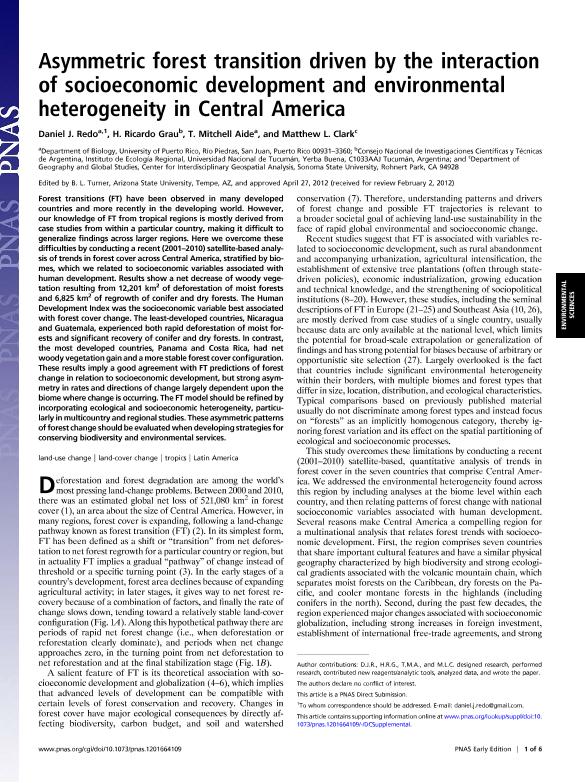Mostrar el registro sencillo del ítem
dc.contributor.author
Redo, Daniel J.
dc.contributor.author
Grau, Hector Ricardo

dc.contributor.author
Aide, T. Mitchell
dc.contributor.author
Clark, Matthew L.
dc.date.available
2023-05-03T22:20:59Z
dc.date.issued
2012-05
dc.identifier.citation
Redo, Daniel J.; Grau, Hector Ricardo; Aide, T. Mitchell; Clark, Matthew L.; Asymmetric forest transition driven by the interaction of socioeconomic development and environmental heterogeneity in Central America; National Academy of Sciences; Proceedings of the National Academy of Sciences of The United States of America; 109; 23; 5-2012; 8839-8844
dc.identifier.issn
0027-8424
dc.identifier.uri
http://hdl.handle.net/11336/196209
dc.description.abstract
Forest transitions (FT) have been observed in many developed countries and more recently in the developing world. However, our knowledge of FT from tropical regions is mostly derived from case studies from within a particular country, making it difficult to generalize findings across larger regions. Here we overcome these difficulties by conducting a recent (2001-2010) satellite-based analysis of trends in forest cover across Central America, stratified by biomes, which we related to socioeconomic variables associated with human development. Results show a net decrease of woody vegetation resulting from 12,201 km2 of deforestation of moist forests and 6,825 km2 of regrowth of conifer and dry forests. The Human Development Index was the socioeconomic variable best associated with forest cover change. The least-developed countries, Nicaragua and Guatemala, experienced both rapid deforestation of moist forests and significant recovery of conifer and dry forests. In contrast, the most developed countries, Panama and Costa Rica, had net woody vegetation gain and amore stable forest cover configuration. These results imply a good agreement with FT predictions of forest change in relation to socioeconomic development, but strong asymmetry in rates and directions of change largely dependent upon the biomewhere change is occurring. The FT model should be refined by incorporating ecological and socioeconomic heterogeneity, particularly inmulticountry and regional studies. These asymmetric patterns of forest change should be evaluatedwhen developing strategies for conserving biodiversity and environmental services.
dc.format
application/pdf
dc.language.iso
eng
dc.publisher
National Academy of Sciences

dc.rights
info:eu-repo/semantics/openAccess
dc.rights.uri
https://creativecommons.org/licenses/by-nc-sa/2.5/ar/
dc.subject
LAND-COVER CHANGE
dc.subject
LAND-USE CHANGE
dc.subject
LATIN AMERICA
dc.subject
TROPICS
dc.subject.classification
Ciencias Medioambientales

dc.subject.classification
Ciencias de la Tierra y relacionadas con el Medio Ambiente

dc.subject.classification
CIENCIAS NATURALES Y EXACTAS

dc.title
Asymmetric forest transition driven by the interaction of socioeconomic development and environmental heterogeneity in Central America
dc.type
info:eu-repo/semantics/article
dc.type
info:ar-repo/semantics/artículo
dc.type
info:eu-repo/semantics/publishedVersion
dc.date.updated
2023-04-26T10:53:06Z
dc.journal.volume
109
dc.journal.number
23
dc.journal.pagination
8839-8844
dc.journal.pais
Estados Unidos

dc.journal.ciudad
Washington DC
dc.description.fil
Fil: Redo, Daniel J.. Universidad de Puerto Rico; Puerto Rico
dc.description.fil
Fil: Grau, Hector Ricardo. Universidad Nacional de Tucumán; Argentina. Consejo Nacional de Investigaciones Científicas y Técnicas; Argentina
dc.description.fil
Fil: Aide, T. Mitchell. Universidad de Puerto Rico; Puerto Rico
dc.description.fil
Fil: Clark, Matthew L.. Sonoma State University; Estados Unidos
dc.journal.title
Proceedings of the National Academy of Sciences of The United States of America

dc.relation.alternativeid
info:eu-repo/semantics/altIdentifier/url/http://www.pnas.org/cgi/doi/10.1073/pnas.1201664109
dc.relation.alternativeid
info:eu-repo/semantics/altIdentifier/doi/http://dx.doi.org/10.1073/pnas.1201664109
Archivos asociados
